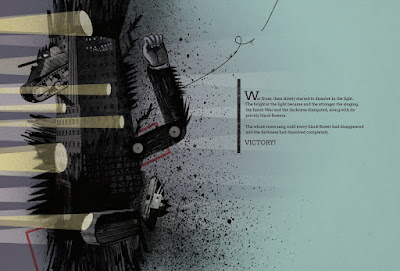Alice Winfield, 12, her mother Posie, father Alan, and older sister Louise, 18, are part of a unique group of people with forgettable faces, "nonfaces that were like tabulae rasas or blank slates." (pg 6) And British Rasas had been serving their country as spies since the days of Henry VIII. Now, however, Louise has decided to leaving spying and have plastic surgery that would give her a recognizable face - something that Alice just can't understand.
But it's 1944, and before she has too much time to think too much about it, Alice is parachuting into Germany with her mother on her first real spying mission and joining her father in Berlin. Her mission is to spy on Adolf Hitler. Posing as a schoolgirl named Ute, Alice wins the Reichs Praktikum for a chance to be an intern in Hitler's household, going where he goes and assessing his mental health. Her mentor for this spy mission is Count Claus Schenk von Stauffenberg, Reichs hero and secretly part of Operation Valkyrie, the plot to kill Hitler, and now Alice is right in the thick of that conspiracy.
In the midst of this intrigue Alice/Ute meets David, a starving Jewish boy who has been hiding out in the house his family used to lived in before they were deported. The house is now occupied by Colonel Ernst Schmelling, a high ranking Nazi. David has been eating scraps of food out of the Schmelling garbage cans to survive. Alice begins sneaking food to David and they gradually become friends. Oddly enough, David never forgets her, recognizing her face each time they meet.
On top of all that, one day Alice is sure she has seen Louise among the crowds of people in Berlin. But what would she be doing there? Is she a double agent, or has she gone over to the other side? Whatever it is, Alice is determined to find Louise and confront her.
With the war turning in the Allies favor, especially after the failure of Operation Valkyrie (not a spoiler, we all know what happened), and the success of the July 6, 1944 Normandy landings (D-Day), things are becoming quite dangerous as the tension mounts.
It took me a while to get into this book, but once I did, I was hooked. The whole business about Rasa confused me at first, but once I realized it was a fiction, I just went with it. It was interesting to see the last days of the Third Reich through Alice's eyes, and Lasky included lots of good information about what it was like to be in Hitler's inner circle.
But there were some things that bothered me. It was a little to repetitive at times, especially in the beginning of the book. And I kept wondering how the local baker was about to bake such wonderful bread and cookies in 1944, when most people were starving (except Nazis, of course). There was also a big error on page 102, which I think was just a typo - it said that was the commandant of Auschwitz was Rudolf Hess, but it was actually Rudolf Höss. Rudolf Hess was a prisoner in the Tower of London in 1944. You can see how easy it is to confuse the two names, though. One last thing bothered me - on page 114 it says there isn't a cozy name for mother in German, but that's exactly was Mutti is. These things will definitely not spoil your reading of Faceless, but as a person with a PhD in Germanic Languages and Literature who's also a little OCD, I just couldn't let them go. However, despite these things, I really did enjoy reading this novel.












